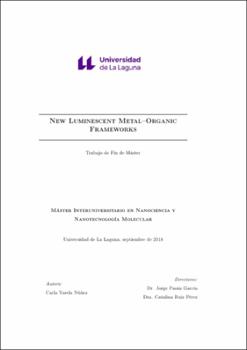New luminescent metal-organic frameworks
Author
Varela Núñez, CarlaDate
2018Abstract
The present master thesis entitled New Luminescent Metal-Organic Frameworks
focuses on the synthesis and characterization of several new metal–
organic frameworks (MOFs), which are a kind of organic-inorganic hybrid
compounds with one-, two-, or three-dimensional structural topologies consisting
of inorganic metal ions/clusters and organic ligands. The relevance of
the new MOFs synthesized dwells in the luminescence properties that they
exhibit.
The construction of new MOFs has been rapidly developed in recent
years, not only due to their interesting molecular topologies and crystal
packing motifs but also due to their potential applications as functional materials.
MOFs can be readily synthesized from the self-assembly of metal
ion nodes with organic ligands. Multi-carboxylic acids have been widely
used to synthesize high dimensional frameworks. In particular, 1,2,4,5-
benzenetetracarboxylate is a versatile ligand that leads to numerous different
coordination polymers with lanthanide ions.
Among the wide variety of properties of interest that a given material can
exhibit, luminescence is attracting an increasing attention due to its potential
application in optical devices for lighting equipment and optical storage, optical switching, and sensing. At this respect, luminescent metal–organic
frameworks (LMOFs) are a quickly growing class of crystalline materials with
great potential for use across a broad range of applications. The lanthanide
elements, which possess partially filled 4f orbitals, can form coordination
polymers that exhibit various coordination geometries even with the same
ligand.
An extensive work has been carried out using 1,2,4,5-benzenetetracarboxylic
acid (H4bta) as ligand and 1,2-di(4-pyridyl)-ethylene (bpe), 1,2,4-
triazole (tz), imidazole (im) and 4,4’-azobis(pyridine) (azpy) in order to perform
cation exchanges. Several lanthanide coordination polymers with good
luminescence properties have been synthesized by hydrothermal method, and
an investigation on the formation of lanthanide coordination compounds
based on the use of cation exchange has also been performed. The seven
LMOFs prepared are, specifically: [Ln(bta)][(CH2)2NH2] (Ln=Tb (1), Ln=Pr
(2)), [Ln(bta)]2(bpe) (Ln= Tb (3), Ln=Pr (4)), [Tb(bta)](im) (5), [Tb(bta)]2
(azpy) (6), and [Tb(bta)](tz) (7).
Single-crystal X-ray diffraction reveals that complex 1 crystallizes in the
to orthorhombic space group P212121, while complexes 2 and 3 in the triclinic
space group P-1. The Pr-complexes obtained are isostructural as deduced
by means of single crystal and powder X-ray diffraction analysis, unlike
Tb-complexes, which are found to possess different crystal structures. Luminescence
measurements reveal that the Tb3+ compounds exhibit several
strong characteristic emission bands for isolated Tb3+ ions in the visible region
when excited between 320 and 375 nm; similarly, the Pr3+ compounds
display the characteristic emission bands for isolated Pr3+ ions.





